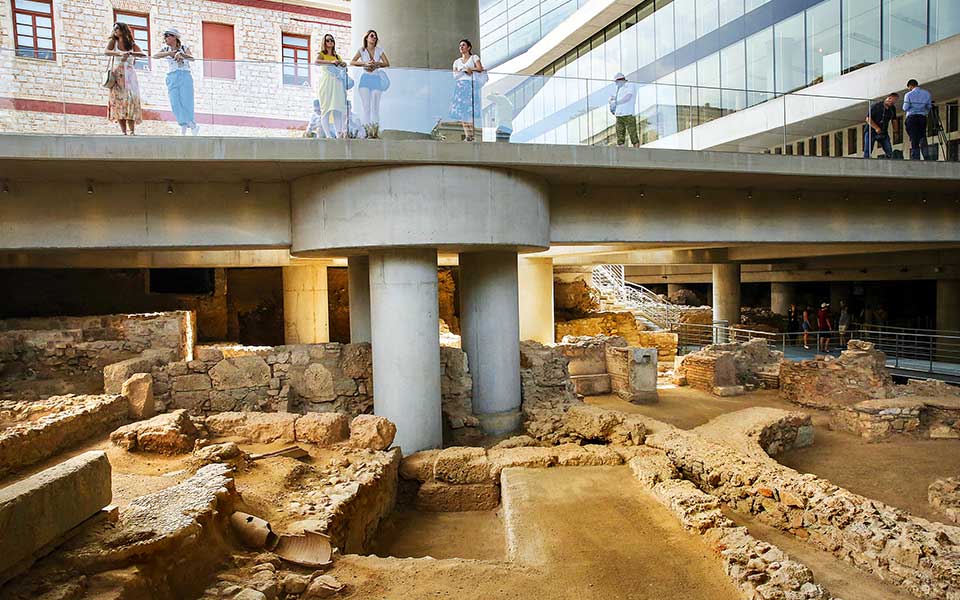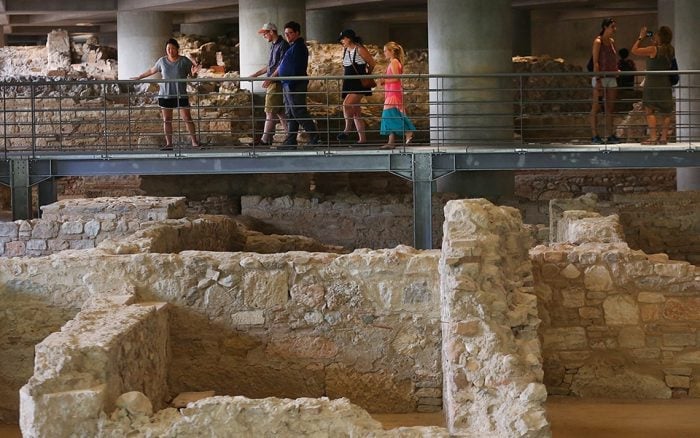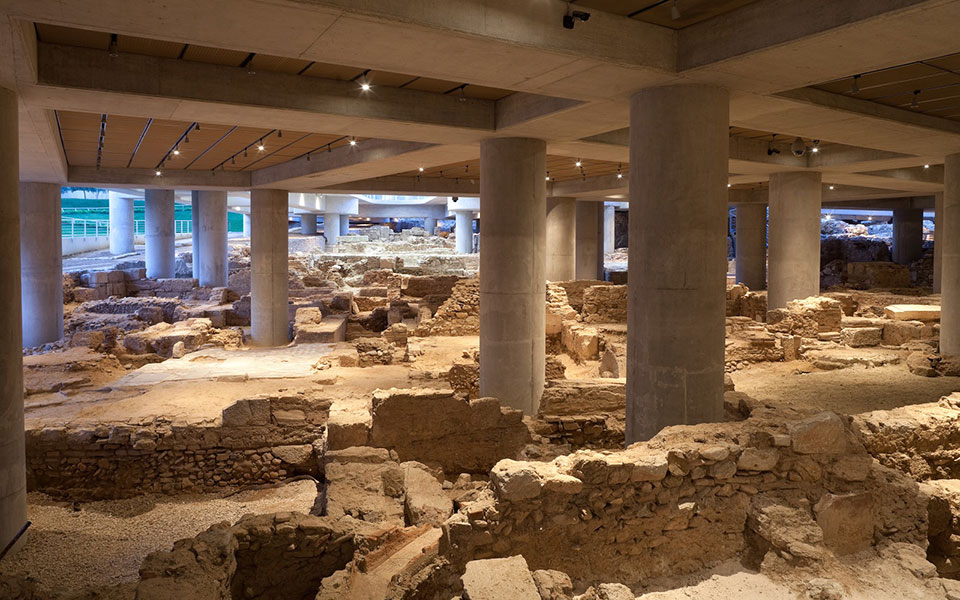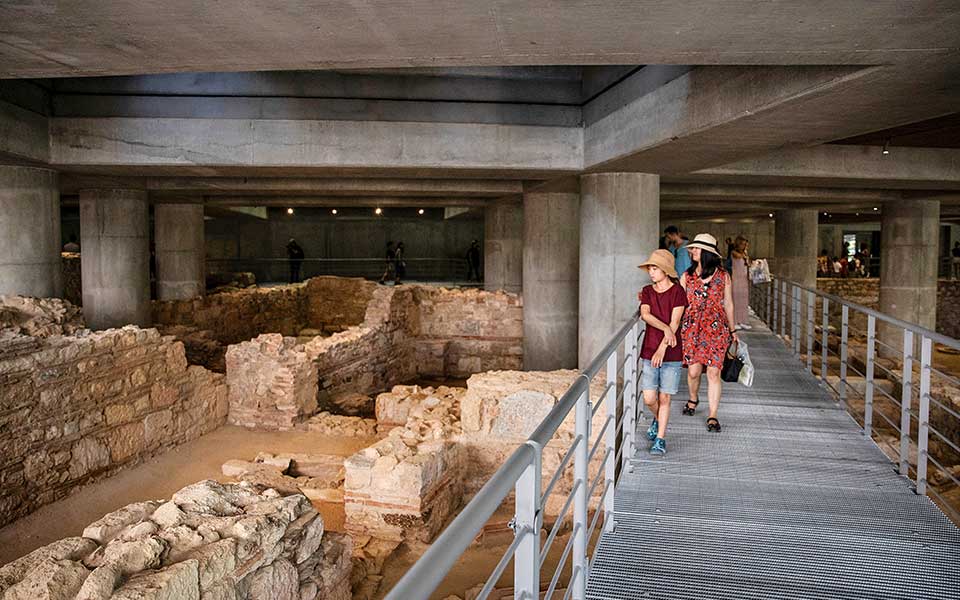Introduction
Nestled in the heart of Athens, Greece, the Acropolis Museum stands as a testament to the city’s rich history and cultural legacy. But beneath the museum’s modern facade lies an even more remarkable story – the remains of an ancient Athenian neighborhood dating back over 4,000 years.

As archaeologists began the excavations to lay the foundation for the Acropolis Museum, they uncovered a veritable treasure trove of the past. Peeling back layer after layer of earth, they exposed a captivating honeycomb of walls, streets, alleys, houses, baths, and workshops – some buried as deep as five meters below the present-day ground level. This ancient neighborhood, long forgotten and buried under the sands of time, had been teeming with life for centuries, waiting to have its story told.
In this blog post, we’ll delve into the remarkable discoveries made at the Acropolis Museum site, exploring how these ancient ruins have shed new light on the daily lives and urban landscape of ancient Athens. We’ll examine the significance of these excavations, the insights they’ve provided into Athens’ rich history, and how the museum has worked to preserve and showcase this remarkable archaeological treasure.
Uncovering the Layers of History
The Acropolis Museum’s excavations began in the early 2000s, as plans were underway to construct a new, modern facility to house the treasures of the Acropolis. Little did the project’s planners know that they were about to uncover one of the most significant archaeological discoveries in the history of Athens.
As the excavation team began to clear the site, they encountered layer upon layer of ancient structures and artifacts, each one offering a tantalizing glimpse into the city’s past. The earliest remains uncovered dated back to the 4th millennium BC, during the Neolithic period, when the area was first inhabited by small farming communities.

As the team continued to peel back the earth, they encountered evidence of Athens’ development into a thriving urban center. Walls, streets, and the remains of houses, workshops, and public baths revealed a complex and vibrant community that had existed for centuries, long before the construction of the iconic Acropolis monuments above.
One of the most remarkable discoveries was the remains of a large, multi-story building that archaeologists believe was a public bath complex, complete with heated rooms, bathing pools, and intricate plumbing systems. The attention to detail and the scale of this structure underscored the level of urban planning and sophistication that had existed in ancient Athens, even in its earliest phases of development.
A Glimpse into Daily Life in Ancient Athens
The excavations at the Acropolis Museum site have provided an unprecedented window into the daily lives of ancient Athenians. As the team carefully uncovered the remains of houses, workshops, and other structures, they were able to piece together a vivid picture of how the city’s inhabitants lived, worked, and interacted with one another.
For example, the remains of several workshops revealed the types of artisanal activities that were taking place in this ancient neighborhood. Archaeologists found the remnants of pottery kilns, metalworking forges, and even a perfume production facility, suggesting that this area was a hub of commercial and industrial activity.

The houses, too, offered insights into the domestic lives of ancient Athenians. The team uncovered the foundations of multi-room dwellings, complete with evidence of kitchens, living spaces, and even private baths. These structures provided a glimpse into the architectural styles and living standards of the city’s inhabitants, challenging the common perception of ancient Athens as a purely monumental and elite-focused society.
Perhaps most intriguing were the discoveries of personal artifacts, such as jewelry, pottery, and tools, which helped to humanize the people who once lived in this ancient neighborhood. These items not only shed light on the material culture of the time but also offered a tangible connection to the individuals who once called this place home.
The Significance of the Acropolis Museum Excavations
The excavations at the Acropolis Museum site have had a profound impact on our understanding of ancient Athens and its development as a major urban center. These discoveries have challenged and expanded our historical narratives, providing a more nuanced and comprehensive picture of the city’s evolution.

One of the most significant aspects of the excavations is the sheer scale and complexity of the ancient neighborhood that was uncovered. The fact that this vibrant community existed for centuries, with a well-developed infrastructure and a thriving economy, underscores the sophistication and importance of Athens long before the construction of the iconic Acropolis monuments.
Moreover, the excavations have shed new light on the everyday lives of ancient Athenians, moving beyond the traditional focus on the city’s political and cultural elite. By uncovering the remains of homes, workshops, and other structures, the team has given a voice to the common people who made up the backbone of ancient Athenian society.
These discoveries have also had important implications for the preservation and presentation of Athens’ cultural heritage. The Acropolis Museum has worked tirelessly to incorporate the excavated remains into the museum’s design, allowing visitors to engage with the city’s history in a more immersive and meaningful way.
By showcasing these ancient ruins alongside the Acropolis’ iconic monuments, the museum has created a powerful and holistic experience that challenges visitors to consider the multifaceted nature of Athens’ past. This approach has not only enhanced the museum’s educational and cultural value but has also served as a model for other archaeological sites around the world.
Preserving the Past for the Future
The Acropolis Museum’s excavations have been a remarkable success story in the field of archaeology and cultural preservation. Through meticulous research, careful excavation, and innovative display techniques, the museum has been able to bring the ancient Athenian neighborhood back to life, offering visitors a unique and engaging window into the city’s past.
One of the most impressive aspects of the museum’s approach has been its commitment to preserving the excavated remains in situ, or in their original location. Rather than simply removing the artifacts and relocating them to the museum’s galleries, the team has worked to incorporate the ancient structures and features directly into the museum’s design.

This approach has allowed visitors to literally walk through the excavated ruins, experiencing the layout and scale of the ancient neighborhood firsthand. The museum has also used advanced display techniques, such as glass floors and elevated walkways, to showcase the excavated remains while still preserving their integrity and context.
In addition to the on-site preservation efforts, the Acropolis Museum has also invested heavily in research and analysis, working to uncover the stories and significance of the excavated artifacts and structures. The museum’s team of archaeologists, historians, and conservators have collaborated to piece together the complex history of this ancient neighborhood, sharing their findings with the public through engaging exhibits, educational programs, and online resources.
The Acropolis Museum’s approach to the excavations has been a testament to the power of archaeology to not only uncover the past but to also inspire and educate the present. By bringing these ancient ruins to life, the museum has created a dynamic and immersive experience that allows visitors to connect with the rich history of Athens in a deeply personal and meaningful way.
Conclusion
The Acropolis Museum’s excavations have been a remarkable journey of discovery, uncovering the secrets of an ancient Athenian neighborhood that had been buried for thousands of years. Through meticulous research, careful excavation, and innovative preservation techniques, the museum has been able to bring this vibrant community back to life, offering visitors a unique and engaging window into the city’s past.
The significance of these excavations cannot be overstated. They have challenged our understanding of ancient Athens, shedding new light on the city’s development and the daily lives of its inhabitants. By showcasing these ancient ruins alongside the iconic Acropolis monuments, the museum has created a powerful and holistic experience that encourages visitors to consider the multifaceted nature of Athens’ history.
As we continue to explore and uncover the secrets of the past, the Acropolis Museum’s excavations serve as a powerful reminder of the transformative potential of archaeology. By preserving and sharing these ancient treasures, the museum has not only enriched our understanding of the past but has also inspired us to consider the enduring legacy of the ancient world and its continued relevance in the modern era.
